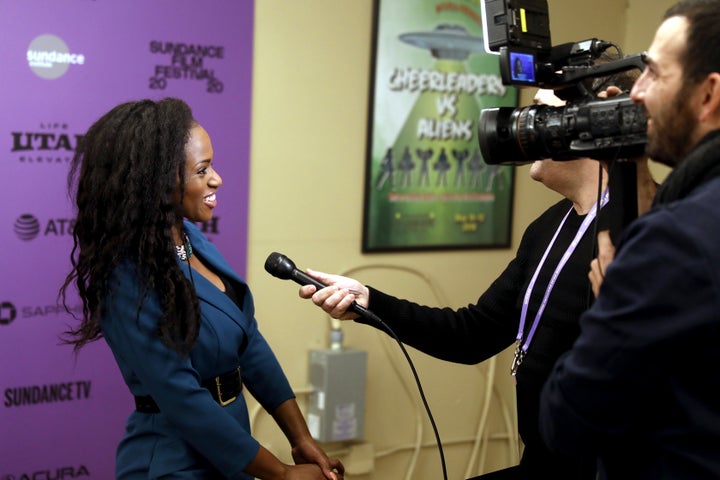Netflix executive Ted Sarandos expressed disbelief Monday in response to a Texas grand jury’s decision to indict the streaming service over its controversial French-language movie “Cuties.”
“It’s a little surprising in 2020 America that we’re having a discussion about censoring storytelling,” Sarandos said.
But is it? Especially about a movie like “Cuties,” which seems particularly poised for this exact kind of discussion?
This is a coming-of-age movie about a Black, Muslim, preteen girl navigating her budding sexuality and the dark realities of being a young girl in a culture that sexualizes and polices women’s and girls’ bodies. Amy (Fathia Youssou, who is 14) is an 11-year-old trapped between the two worlds of her loving but unstimulating home life, dictated by prayer and obedience, and the world of a group of rebellious cool girls at school whom she desperately wants to fit in with.
In this case, fitting in means dressing like them, in revealing crop tops and short skirts, talking about boys and sex, and rehearsing suggestive dance moves as part of the group’s “twerk team.” It’s these elements of the film that have obviously proved the most controversial.
The Oct. 6 indictment by a grand jury in rural Tyler County, which names Sarandos and his co-CEO, Reed Hastings, says the movie knowingly promotes “visual material which depicts the lewd exhibition of the genitals or pubic area of a clothed or partially clothed child who was younger than 18 years of age at the time the visual material was created, which appeals to the prurient interest in sex, and has no serious, literary, artistic, political, or scientific value.”
Criticism of “Cuties” (the French title is “Mignonnes”) has likened the film to glorified child pornography. It’s not child pornography, but while there are moments of beauty and poetry in the movie, there’s also imagery that’s difficult, jarring and brings up questions about how to effectively critique the sexualization of young girls without sexualizing them — particularly for the gaze of adults — in the process.
But “Cuties” is primarily interested in the gaze, in the perspective, of its young protagonist. Amy is constantly looking and observing, through phone screens, from behind fences, through cracks in doors.
“I met with hundreds of preteens who told me their stories. I needed to know how they felt about their own femininity in today’s society and how they dealt with their self-image at a time when social media is so important.”
- writer-director Maïmouna Doucouré
“Our girls see that the more a woman is overly sexualized on social media, the more she is successful,” writer-director Maïmouna Doucouré explained in a director’s statement included in the press release for the film. “Children just imitate what they see, trying to achieve the same result without understanding the meaning. It is dangerous.” (Doucouré declined to comment on the Netflix indictment.)
In one scene, Amy awkwardly attempts to seduce an older cousin when he learns she stole his phone. She then locks herself in the bathroom, takes a picture of her vulva and posts it to social media in a desperate attempt for validation and approval. We don’t see the picture, but the implication of it is heartbreaking and disturbing enough. Later, in school, a boy in class slaps Amy’s butt as she walks to the chalkboard.
“She’s the one putting up nude photos of herself online!” the boy protests when he’s reprimanded by a teacher. “You’re the slut, not me!”
In the climax of the movie, Amy and her friends (or frenemies, it’s always changing) perform a routine at a dance competition that horrifies the judges and audience alike. Dressed in tight crop tops and tiny shorts, the four girls twerk, gyrate, suggestively suck their fingers, arch their backs and pat their crotches. The routine seems to stretch on forever, becoming gradually more horrifying to watch, which is perhaps the point. Their choreography is reminiscent of the older, sexy dance groups they obsessively follow on social media, the groups with thousands of likes. But it isn’t entertaining. It is implicating.
At one point, the camera cuts away from the girls to a medium shot of a twentysomething dude who nods pleasantly to the routine while, just behind him, an older Black woman attempts to cover the eyes of her young daughter who is eagerly craning her head to get a better look at what’s happening on stage. And there’s value in this juxtaposition, in what it says about being a young girl, about what it means to be both seen and unseen in your girlhood. There’s value, too, in the moment that comes toward the end of the dance routine, as the music abruptly fades out and Amy suddenly freezes while her friends beckon her to continue dancing. She can’t move. Tears begin to brim and fall down her cheeks. She rushes off stage. Perhaps too pat an ending, the film closes with Amy jumping rope with a group of girls her own age, a return, it seems, to innocence, or at the very least a kind of autonomy.

Being a Black preteen girl is a minefield of insecurity, discovery and, yes, sexual awakening. This awakening takes place in a landscape where you are constantly forced to question your desires and your desirability, a time in which you’re clumsily grasping for ways to feel bodied in a body you don’t understand, a time when messages about what it looks like to be a “woman” are being constantly thrown at you from all directions. It can be scary, and disturbing and exhilarating all at once. As someone who has had to struggle with the aftermath of sexual trauma, an aftermath that for so many survivors often entails blaming yourself and your body rather than the adults who sexualize your body, “Cuties” brings up a lot of questions around what autonomy really looks like, especially for the most vulnerable and marginalized among us.
There is a delicate, fine line in approaching stories that explore teenage and preteen sexuality with a spirit of honesty versus a spirit of exploitation. Consent is a big part of this, and care ― how much were the young actresses prepped and allowed to process what they were acting out? The question always boils down, in my mind, to perspective. I’ve often thought about both the 1962 and 1997 film adaptations of Vladimir Nabokov’s “Lolita,” for instance, which feature underaged actresses in the highly sexualized title role (Sue Lyon was 14; Dominique Swain was 15). I think about the controversies around the novel and the movies, the debates, the online romanticization of the Lolita character by teenage girls on Tumblr and Instagram that focuses more on her cool clothes and her heart-shaped glasses than on the fact that she is a victim. I think about how easily nuance can be subsumed by our own bias.
I say all this to say: I get why “Cuties” is too much for some people; I get the desire to get rid of it, pretend it doesn’t exist. There were many moments while watching the movie that I wanted to look away. It’s painful, and it is painful particularly because it is real. There are little Amy Diops all over the world, Black girls with kinky hair and dark skin and no curves who desperately want to feel like they belong and are implicitly, gradually made to think that sexuality is the only currency with which they can truly find belonging, happiness, validation, love.
“I had the idea for ‘Cuties’ when, one day during a neighborhood gathering in Paris, a group of very young dancers came on the stage and they were dancing like we are used to seeing in video clips,” Doucouré said in her director’s statement.
“They were only 11 years old. So I decided to spend the next year and a half doing research. I met with hundreds of preteens who told me their stories. I needed to know how they felt about their own femininity in today’s society and how they dealt with their self-image at a time when social media is so important.”
There’s something to be said for this intentionality. This movie is told firmly from the point of view of Amy; it forces the viewer to inhabit what it feels like for a girl at that age to wade into such confusing and treacherous waters. Some of the feelings that come up are joyful, and many of them are horrific. The choice between looking on blithely or looking on in horror is at the crux of what, to my mind, ultimately makes this a film with something valid and valuable and interesting to say.
Everything is so arbitrary. Recently, Netflix deleted an episode of the British satirical comedy show “Little Britain,” which featured jokes that were deemed racially insensitive. Critics of “Cuties” pointed out the incongruity of a movie like this: If racially insensitive jokes can be censored on the streamer, surely a film like “Cuties” should be as well? This act of deleting, erasing and stripping away is tantamount to justice or progress to some people. To me, it feels like someone hurriedly sweeping something under the rug. We delete racist jokes from the record, and then what?
Amid all this rage and all this concern, I wonder how much detractors of the film (many of whom have obviously not seen it but merely have read CliffsNotes of what happens) actually care about the young Black, immigrant, Muslim girl portrayed in the film and young Black girls like her? Their lives, their experiences, their insecurities, their struggles, their joys? Or are they in judgment of these girls instead? And how is this judgment restorative and affirming and culture shifting? These are questions worth asking, and the questions that people rarely seem to ask, probably because their concern and their outrage are only so deep. We are all guilty of this.
There are some who might contend that “Cuties,” in its bid to shine light on a societal ill, is merely contributing to it. If “Cuties” ended with the girls winning the dance competition and Amy riding off into the sunset with the trophy, it would be so much easier to dismiss the movie’s value and, more important, its intention. Instead, the film ends with Amy not just seeing but feeling how bad it feels to be objectified, and indeed to objectify yourself, when you don’t fully understand what you’re doing or why.
Ultimately, in Doucouré’s eyes at least, “The real question of ′Cuties’ is: Can we as women truly choose who we want to be beyond the role models that are imposed upon us by society?”
